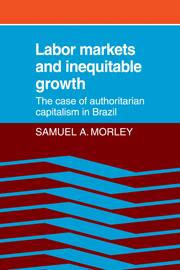Book contents
- Frontmatter
- Contents
- List of tables and figures
- Preface
- Part I Growth, employment creation, and inequality in Brazil
- 1 Introduction
- 2 Production and employment trends in the postwar period
- 3 Rising inequality since 1960
- 4 The meaning and interpretation of rising inequality in a growing economy
- 5 Evidence on absolute improvements and upward mobility
- Part II The effect of supply and demand on labor markets during rapid economic growth
- Data appendix
- Bibliography
- Index
3 - Rising inequality since 1960
Published online by Cambridge University Press: 07 October 2011
- Frontmatter
- Contents
- List of tables and figures
- Preface
- Part I Growth, employment creation, and inequality in Brazil
- 1 Introduction
- 2 Production and employment trends in the postwar period
- 3 Rising inequality since 1960
- 4 The meaning and interpretation of rising inequality in a growing economy
- 5 Evidence on absolute improvements and upward mobility
- Part II The effect of supply and demand on labor markets during rapid economic growth
- Data appendix
- Bibliography
- Index
Summary
Earnings data
We have seen that both recent periods of economic growth in Brazil brought substantial increases in employment. Judging by the type of jobs created and relative rates of productivity growth, the miracle period appears to have been the more successful of the two. But what was the distribution of earnings that went along with this rise in employment? This question is interesting and important in its own right, since rising inequality between 1960 and 1970 sparked an international debate over Brazilian economic policy and the trickledown growth strategy. Was rising inequality a feature of the miracle period (1967–73) as well?
To answer the distribution question, we must analyze earnings. Earnings data are also necessary to evaluate the effect of any growth strategy on employment, for they indicate the type of jobs created. As we have seen, employment grew rapidly, and total underemployment fell during the miracle period. But these results could have been caused by either of two entirely different labor market conditions. In what might be called the “pull” model of employment growth, the expansion in good jobs more than keeps pace with increases in labor supply. Formally the labor demand curve shifts out relative to the labor supply curve so that wages and employment both increase.
A much less cheerful result occurs when the supply curve shifts out relative to demand. This we will call the “push” model.
- Type
- Chapter
- Information
- Labor Markets and Inequitable GrowthThe Case of Authoritarian Capitalism in Brazil, pp. 53 - 71Publisher: Cambridge University PressPrint publication year: 1983



